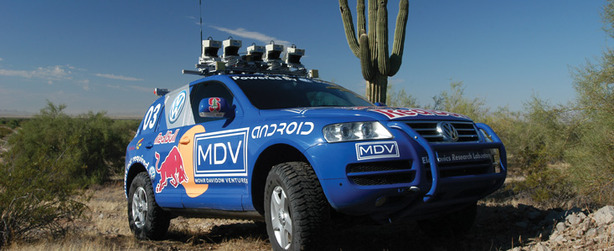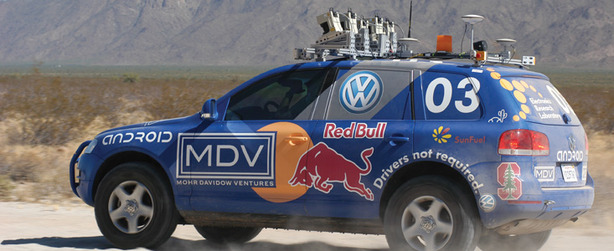Herbie Goes Off-Road
DARPA, the Defence Advanced Research Projects Agency, is a US government organisation that researches ideas with military applications which are simply too ‘far out’ for other research organisations to consider seriously.The Grand Challenge has been running for several years, and while the challenge alters each time, it always centres around teams building a vehicle capable of driving itself around a set course. In 2005, the driverless cars had to navigate a 200-mile route through California’s Mojave Desert to bag a $1 million prize. It may come as no surprise that Stanford University, the base of the Folding@home project, was also the home of the team that won the 2005 Challenge.
The Stanford team’s automated vehicle was a highly modified Volkswagen Touareg R5 SUV called Stanley. To perceive its environment, Stanley was equipped with five lasers, one camera, and two LIDAR (light detection and ranging) sensors as well as a rack of six ‘ruggedised’ Pentium M blade servers that ran the software.

We spoke to Mike Montemerlo, senior research engineer at the Stanford Artificial Intelligence Laboratory and software lead for Stanley, to find out about the car. "The two biggest challenges were reliability and speed," he told us. "In other words, we had to make sure Stanley could finish the course and then work on making him finish first. We worked on the software for a long time to make it reliable, but proving that it was meant several months in the desert testing the robot. To make Stanley faster, part of the group developed a road detector using computer vision, which allowed Stanley to drive faster in open desert."
We asked Montemerlo to describe Stanley’s level of intelligence. "Stanley’s understanding of the world is simple. He thinks of everything as one of three groups: things he can drive on, things he can’t drive on and things he doesn’t know he can drive on (which he also drives on!). This level of understanding is enough to drive hundreds of miles through the desert without a problem. However, if we are to have robots driving in real urban environments, obviously they’ll have become much more intelligent."
Like many of the AIs included in this feature, Stanley also utilises machine learning to improve its performance.

"We labelled the obstacles in a stretch of terrain that we believed to be representative of desert driving," Montemerlo said. "Then Stanley’s software was able to optimise the parameters of the obstacle detection function in order to most accurately predict these obstacle labels.
"Machine learning was also used in the road detector that Stanley used to drive faster on clear roads. The lasers are very accurate but only see far enough to drive at 25mph. They would identify a section of road close to the vehicle as drivable. This camera would then find a drivable road at a longer range that looks like the drivable road identified by the laser. In effect, the laser is “teaching” the camera what drivable road looks like. This is called 'self-supervised' learning."
Stanley won the Grand Challenge in 2005, but the year before none of the cars finished, so it was a massive step forward in the field of automated vehicles. However, Montemerlo believes that owning cars that can drive us to Sainsbury’s for the weekly shopping while we read a copy of our favourite magazine (We hope it'd be Custom PC - Ed.) isn’t going to happen any time soon. "We’re still a long way from commercially available driverless cars – perhaps 20 years. We’ll need to show that the vehicles are more reliable than human drivers."

MSI MPG Velox 100R Chassis Review
October 14 2021 | 15:04









Want to comment? Please log in.